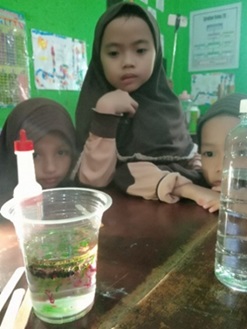Edukasi Karakteristik Warna dengan Metode Eksperimen untuk Siswa Sekolah Dasar Education of Color Characteristics with Methods Experimental for Elementary School Students
Main Article Content
Abstract
Color is one of the knowledge that children must know. Therefore, since childhood, the introduction to color has been carried out, one of which is in elementary school. Until now, elementary schools that are partners tend to use the method of lecture, discussion, and memorization. Therefore, this service aims to introduce to partners the experimental method as one of the learning methods that has various advantages. The service began with group division, delivery of material about color characteristics, and conducting six kinds of experiments, namely walking water, changing color, rainbow in the plate, rainbow rain, lava lamp, and changing color with cabbage. From the service activities, it was found that students could understand the characteristics of colors correctly and were very enthusiastic about conducting experiments. In addition, the cohesiveness of students in experimenting is also intertwined. With this service activity, it is hoped that partners can make experimentation as one of the interesting classroom learning methods for students.
Downloads
Article Details

This work is licensed under a Creative Commons Attribution-ShareAlike 4.0 International License.
Authors who publish with this journal agree to the following terms:
- Any article on the copyright is retained by the author(s).
- Author grant the journal, right of first publication with the work simultaneously licensed under a Creative Commons Attribution License that allows others to share work with acknowledgment of the work authors and initial publications in this journal.
- Authors are able to enter into a separate, additional contractual arrangements for non-exclusive distribution of published articles of work (eg, post-institutional repository) or publish it in a book, with acknowledgment of its initial publication in this journal.
- Authors are permitted and encouraged to post their work online (e.g., in institutional repositories or on their websites) prior to and during the submission process, as can lead to productive exchanges, as well as earlier and greater citation of published work.
- The article and any associated published material is distributed under the Creative Commons Attribution-ShareAlike 4.0 International License
References
Ali, M., Santriawati, & Rahma, N. (2023). Meningkatkan Hasil Belajar IPA Menggunakan Metode Eksperimen Kelas VI Sekolah Dasar Jurnal Cipta Media Harmoni. 3(2). https://doi.org/doi.org/10.53624/ptk.v3i2.150
Asih, T., & Barriyah, Q. I. (2023). Meningkatkan Kemampuan Mengenal Warna Dengan Metode Eksperimen Warna Pada Kelas II SD Negeri Pleret Lor. Jurnal Pendidikan Indonesia (JOUPI), 1(4), 261–266. https://doi.org/10.62007/joupi.v1i4.172
Bae, G. Y., Olkkonen, M., Allred, S. R., & Flombaum, J. I. (2015). Why some colors appear more memorable than others: A model combining categories and particulars in color working memory. 144(4). http://dx.doi.org/10.1037/xge0000076
Balabanoff, D. (2023). Color, light, and birth space design: An integrative review. Design for Health, Faculty of Design, OCAD University, Toronto, Canada. https://doi.org/10.1002/col.22842
Gil, S., & Le Bigot, L. (2014). Seeing life through positive-tinted glasses: Color–meaning associations. 9(8).
Guang, X. L., & Xiang, F. H. (2022). From the color composition to the color psychology: Soft drink packaging in warm colors, and spirits packaging in dark colors. 47(3), 758–770. https://doi.org/10.1002/col.22748
Guntur, & Zainal. (2022). Penerapan Metode Eksperimen Dalam Meningkatkan Hasil Belajar Siswa Kelas IV SD. Jurnal Pendidikan Guru Sekolah Dasar 2(10) https://doi.org/Doi.Org/10.26858.
Guo, H., Asliza, A., & Rose, D. R. (2023). Research on the Application of Color Psychology in Fashion Design. 7(18). https://doi.org/10.23977/aetp.2023.071801
Haniyah, L., Bektiarso, S., & Wahyuni, S. (2021). Model Pembelajaran Kooperatif Tipe NHT(Numbered Head Together) Disertai Metode Eksperimen Pada Pembelajaran IPA Fisika SMP. Jurnal Pembelajaran Fisika 3(1). https://doi.org/Doi.Org/10.19184/Jpf.V3i1.23239.
Hidayati, S., Robingatun, R., & Saugi, W. (2020). Meningkatkan kemampuan mengenal warna melalui kegiatan mencampur warna di TK kehidupan elfhaluy Tenggarong. Jurnal Pendidikan Anak Usia Dini 4(1), 23–37. https://doi.org/10.24853/yby.4.1.23-37
Meilani. (2013). Teori Warna: Penerapan Lingkaran Warna dalam Berbusana. Humaniora, 4(1), 326–338. https://doi.org/10.21512/humaniora.v4i1.3443
Roestiyah, N. (2008). Strategi Belajar Mengajar. Rineka Cipta.
Snow, B., & Froehlich, H. (1920). The Theory of Color and Practice. The Prang Company.
Solikati, N. (2021). Peningkatan Prestasi Belajar IPA Materi Rangkaian Listrik Sederhana Dengan Metode Eksperimen. Jurnal Terapan Pendidikan Dasar Dan Menengah, 1(2). 1(2). https://doi.org/10.28926/Jtpdm.V1i1.1.
Wandini, R., Bariyah, C., Lubis, H., Nur, N., & Mardhatillah, S. (2022). Metode Eksperimen pada Proses Pembelajaran Perubahan Wujud Benda pada Sekolah Dasar Jurnal Pendidikan Dan Konseling (JPDK) 4(3). https://doi.org/10.31004/jpdk.v4i3.5006
